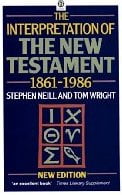[caption id=“attachment_668” align=“alignleft” width=“80” caption=“Stephen Neill and N. T. Wright”]  [/caption] Neill’s stated purpose for his book was “to provide a narrative [about the interpretation of the New Testament] that can be read without too much trouble by the non-theologian who is anxious to know and is prepared to devote some time to the subject” ( ix). This task he seems to have done masterfully well, with a comparatively frugal use of footnotes to set forth “the necessary apparatus of scholarship” ( ix). While this history might have proved tedious, Neill has managed to produce a cogent narrative that, at times, may well carry the interested student into the situation or the time being described.
[/caption] Neill’s stated purpose for his book was “to provide a narrative [about the interpretation of the New Testament] that can be read without too much trouble by the non-theologian who is anxious to know and is prepared to devote some time to the subject” ( ix). This task he seems to have done masterfully well, with a comparatively frugal use of footnotes to set forth “the necessary apparatus of scholarship” ( ix). While this history might have proved tedious, Neill has managed to produce a cogent narrative that, at times, may well carry the interested student into the situation or the time being described.
One of the work’s great strengths is the detail with which Neill and Wright investigate each character and movement included in the narrative. While the level of detail could prove cumbersome, it does provide a valuable opportunity to ‘meet’ some of the giants in the field. As a result, after this perusing this introduction, readers will probably find themselves much better prepared to read, critique, and make use of the positions investigated. Likewise valuable is the even-handed portrayal Neill and Wright give of the various theologians they cover, irrespective of whether they would personally support or object to these theologians’ assertions. For instance, although Neill and Wright are considerably more enthusiastic when writing about the Cambridge trio than when they write figures like Baur, even in this latter case, they do not villanize characters like Baur.
Finally, the book’s summary section tries to encourage continued study of the New Testament. As it says, “The New Testament is concerned with proclamation. It is a Kerygma, the loud cry of a herald authorized by a king to proclaim his will and purpose to his subjects. It is Euangelion, good news, sent to those who are in distress with the promise of deliverance. It is the Word of the Lord—and in the East a word is no mere vibration in the atmosphere, it is a living power sent forth to accomplish that for which it is sent” ( 448–49; italics original). Thus, the chronicle that Neill and Wright provide in this work moves, in their minds, toward establishing a better understanding of the New Testament’s message, which must be proclaimed and heard in all of creation.
In this post:[caption id=“attachment_668” align=“alignleft” width=“80” caption=“Stephen Neill and N. T. Wright”]  [/caption]
[/caption]